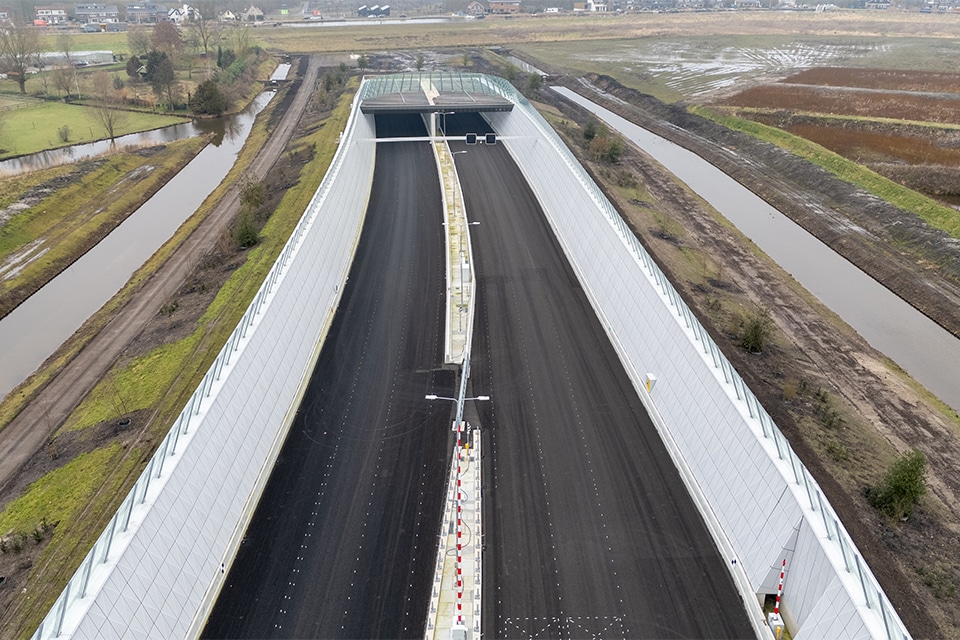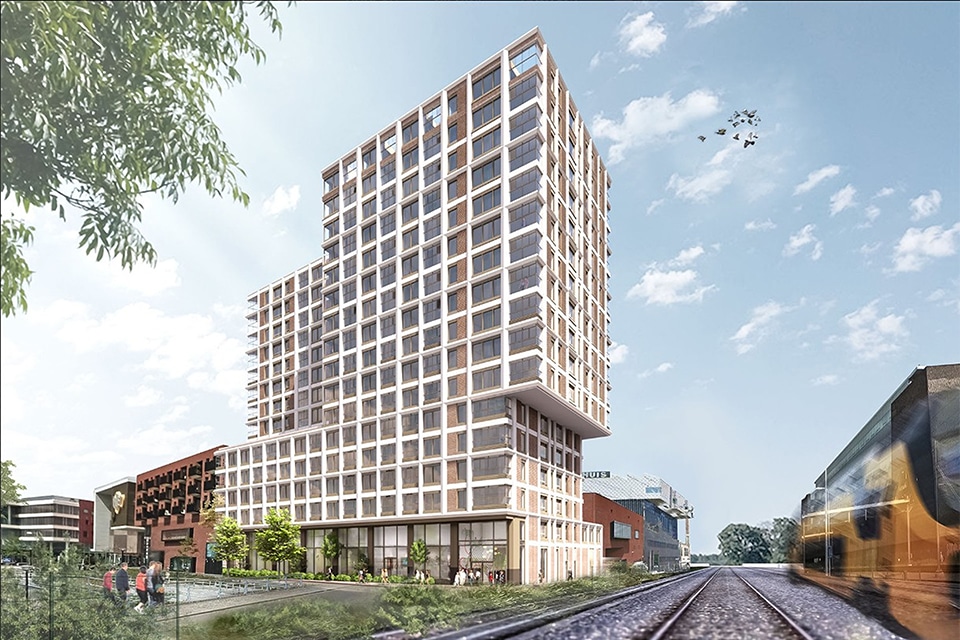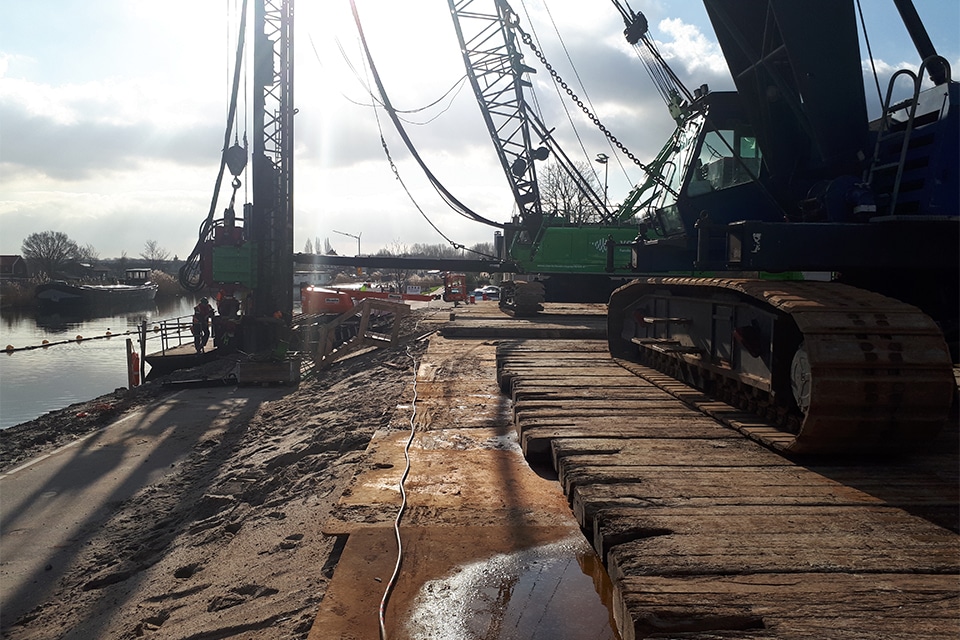
Building and installing over a biomass incinerator
On July 8, the consortium of Bouwonderneming Stout B.V., Vyncke N.V. and Haffner Energy SAS put the finishing touches on the bio-energy plant at Afval Energie Bedrijf (AEB) Amsterdam. A week later, the plant was put into operation for the first time. By the end of this year, the plant should be fully operational. Some 25,000 homes in the city will then be supplied with sustainable heat and some 27,000 with green electricity.
Text | Patricia van der Beek Image | Construction Company Stout B.V.
Every year, the AEB bioenergy plant converts up to 100,000 tons of low-grade prunings and waste wood to renewable energy. This is wood that is not suitable for high-value applications such as paper production or wood processing. The branches, twigs, small chips and sawdust residues come from landscape management and woodworkers in a radius of up to 150 kilometers from Amsterdam. The prunings and waste wood are dumped and stored in storage bunkers, eventually going into the incinerator. A large turbine provides the energy conversion.
International cooperation
Within the consortium, Stout was responsible for the architectural part and site design, the Belgian company Vyncke for the incinerator and the French company Haffner Energy for the water/steam cycle including turbine. Installation specialist Van Dorp was involved in the project at an early stage to help think about the building-related installations: electricity, heating, air treatment and plumbing. In a construction team, consisting of the four aforementioned parties and client AEB, the bioenergy plant was designed and realized.
In the display case
"The location and process plant were guiding factors in the design and construction," says Stout's manager Ferry Moerland. "The building is along the A10, on a site originally intended for office construction. The bioenergy plant had to match this in appearance. The architect conceived a representative building with a lot of glass, which puts the bioenergy plant in the showcase, so to speak." Because of the site's office zoning, only weekday transports are allowed. Thus, no waste wood is delivered on weekends and holidays. However, the plant must run continuously. For this reason, the bioenergy plant has huge storage bunkers, with walls as high as 13.5 meters. Thus, there is sufficient capacity for a substantial supply.
Heavy duty turbine table
As for the structural part and building-related installations, the bioenergy plant was literally built around the process plant. "We first realized the foundation and floor, incorporating Van Dorp's piping," Moerland says. "Then Vyncke and Haffner Energy assembled the combustion plant and turbine. For that turbine, which causes enormous vibrations, we built a heavy turbine table. This consists of six concrete columns of 1x1x6 meters, with a solid concrete table top of 75 square meters and a thickness of 1.6 meters on top."
Working at a height of 24 meters
Only when the process plant was in place did Stout build the walls and roof of the 24-meter-high bioenergy plant. So part of the work took place above the incinerator and turbine, which required preparation, attention and safety measures. "This also applied to our mechanics," says Van Dorp's Senior Project Manager Alexander Nevrlka. "Installing a rainwater drain at a height of over 20 meters is no easy task. It was also difficult to find a suitable aerial platform. Because the process plant was already there, there was little room to maneuver."
Sustainable installations
When asked what characterizes the building installations, Nevrlka replied, "The heating system runs on energy generated by the bioenergy plant itself. Furthermore, energy-efficient applications such as underfloor heating and ventilation with heat recovery contribute to the sustainable character of the building." Van Dorp also developed an installation that controls the temperature and humidity in the storage bunkers. For the water connections at the incinerator, Van Dorp made two pressurization systems: one for the fire extinguishing equipment and one for the so-called "pushers" to cool dust accumulation in the boilers.
Common goal
With completion behind them, both men look back on a project that went smoothly. "The cooperation and atmosphere were excellent," Nevrlka says. Moerland adds, "Within our international consortium we sometimes experienced cultural differences. Yet these did not stand in the way of our common goal, which was to deliver energy on July 15. We managed to do that together within an eighteen-month schedule."
Construction Info
Client AEB Amsterdam
Chief Structural Engineer SWINN the structural engineers BV, Gouda
Construction general contractor Bouwonderneming Stout B.V., Hardinxveld-Giessendam
Project info
13.5-meter-high concrete walls
Characteristic of AEB Amsterdam's bioenergy plant are the tall landfill bunkers, in which the waste wood is collected and stored. The heavy concrete walls of these bunkers, with a height of no less than 13.5 meters, are the work of BetoLinQ contractors B.V.. The specialist in large, complex concrete works also realized the 5-meter-high basement walls.
"A challenge in the realization of these high walls was that we had to pour them in one go," explains BetoLinQ director Ruud van den Braak. "To this end, we engineered and formed the formwork ourselves. Another challenge involved vibrating the concrete. We normally do this by hand, but this is not practical at a height of 13.5 meters. Especially for this project, we developed an automatic winding and unwinding vibrator. This is equipped with wagon wheels at the bottom, which are matched to the thickness of the box. This allowed the vibrator, rolling over the formwork, to vibrate the concrete off the walls."
Set and arm faster
BetoLinQ also devised solutions to pour the walls as efficiently as possible. Van den Braak: "Getting the boxes straight, for example, is a difficult and time-consuming job. We applied steel beams to the formwork, which we used to link the boxes together. This allowed us to transfer the shuttering plates from one wall to another in one go, and we didn't have to set the boxes piece by piece. Another solution that saved us a lot of time was prefabricating reinforcement mats." Van den Braak looks back on a project that went well: "Everything went exactly as we had thought of beforehand. Moreover, the cooperation with Stout Construction Company was very pleasant."



